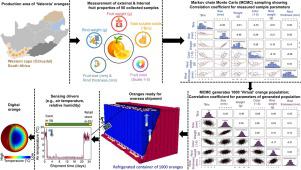Resources, Conservation and Recycling ( IF 13.2 ) Pub Date : 2022-08-04 , DOI: 10.1016/j.resconrec.2022.106585 Daniel Onwude , Flora Bahrami , Chandrima Shrivastava , Tarl Berry , Paul Cronje , Jade North , Nicola Kirsten , Seraina Schudel , Eleonora Crenna , Kanaha Shoji , Thijs Defraeye

|
Currently, there are differences in the quality loss between individual fruit upon arrival at retail. These differences in fruit quality stem from pre-harvest biological variability between individual fruit at harvest and postharvest variations in hygrothermal conditions between refrigerated shipments. The impact of these pre-harvest biological and postharvest variability on the final quality of each fruit that reaches the consumers remains largely uncharted. In this study, we addressed this knowledge gap by developing physics-based digital twins of orange fruit to unveil how pre-harvest and postharvest variability affect the final fruit quality upon arrival at retail. Markov chain Monte Carlo method was used to generate a realistic 'virtual' population of 1000 individual orange fruits at harvest. Afterwards, the impact of pre-harvest biological variability and variations in hygrothermal conditions between shipments on several orange quality metrics, including mass loss, fruit quality index (FQI), remaining shelf life (RSL), chilling injury severity (CI), total soluble solids (TSS), color, and Mediterranean fruit fly (MFF) mortality was quantified. Results showed that pre-harvest biological variability causes variations in mass loss of oranges at retail by up to 1.2%, FQI by up to 5% and RSL by more than 2 days. The postharvest variability between shipments causes high variations in mass loss of oranges at retail by up to 4%, FQI by more than 20%, RSL up to 3 days, and CI up to 5%. The study also revealed that compared to pre-harvest biological variability, postharvest variability between shipments could increase the variations in RSL of oranges at retail by 75%, FQI by 50%, and mass loss by ∼10%. This work helps improve our understanding of the variability in the end fruit quality upon arrival at retail.
中文翻译:

物理驱动的数字双胞胎,用于量化采前和采后变异性对橙果最终质量演变的影响
目前,单个水果在到达零售时的质量损失存在差异。水果质量的这些差异源于收获时单个水果之间的收获前生物学差异和冷藏运输之间的湿热条件的收获后变化。这些采前生物学和采后变异性对到达消费者手中的每种水果的最终质量的影响在很大程度上仍是未知数。在这项研究中,我们通过开发基于物理的橙色水果数字双胞胎来解决这一知识差距,以揭示收获前和收获后的变异性如何影响到达零售店时的最终水果质量。马尔可夫链蒙特卡洛方法用于在收获时生成一个由 1000 个单独的橙色水果组成的现实“虚拟”种群。然后,收获前生物变异性和装运之间的湿热条件变化对几个橙子质量指标的影响,包括质量损失、水果质量指数 (FQI)、剩余保质期 (RSL)、冷害严重程度 (CI)、总可溶性固体 ( TSS)、颜色和地中海果蝇 (MFF) 死亡率被量化。结果表明,收获前的生物变异性导致零售时橙子的质量损失变化高达 1.2%,FQI 高达 5%,RSL 超过 2 天。装运之间的收获后差异导致零售时橙子的质量损失差异高达 4%,FQI 超过 20%,RSL 长达 3 天,CI 高达 5%。该研究还表明,与收获前的生物变异性相比,装运之间的采后变异性可能会使零售橙子的 RSL 变化增加 75%,FQI 增加 50%,质量损失增加约 10%。这项工作有助于提高我们对到达零售店时最终水果质量变异性的理解。


























 京公网安备 11010802027423号
京公网安备 11010802027423号